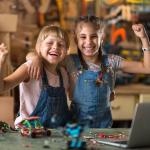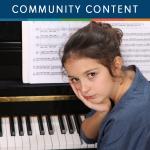There’s nothing quite like the fun and freedom of the summer sun. And the best way to feel the warmth of the season’s vibes is to jump into a camp with friends. But which one to choose? With so many activities and opportunities, it can be challenging to choose an environment that fuses development with entertainment.
What about a camp where your kid, especially a teen, can build empathy, patience, creative problem-solving skills and better communication? Someplace where their impact would be incredible and so would the relationships they create. It’s not what you might think.
“The idea that someone with a disability can’t contribute anything of value is completely inaccurate,” says Joanne Alicea, CEO and founder of Ability Tree First Coast (ATFC), who is also a mom to a child with Down syndrome. Understanding how atypical peers navigate the world fosters camaraderie and empathy. They’re interacting with people who have the same thoughts, emotions and desires, who may not be able to express or communicate them in traditional ways.
“We’re more alike than different. We all want to be valued,” Joanne notes. “A level of compassion grows when you see the value in a person.” She has been running camps for individuals with disabilities for eight years. The organization supports people with disabilities and their families with activities, camps and parent’s night out. She has seen firsthand how all kids benefit from the interactions of their peers, with and without disabilities.
One such child is Patrice Barge, who is on the autism spectrum and has a diagnosis called Neurofibromatosis type 1 (NF1). The condition causes tumors to grow on the nerves, and symptoms include light brown patches on the skin, freckles on the armpits or groin and skeletal abnormalities.
“Patrice either forms a bond or doesn’t; that’s her personality,” says mom, Polly, of her daughter. “But she always finds a coach to connect with. The high school kids always seem to find something in common with her.”
From the Volunteers
Maryn Walker is a teen volunteer for ATFC. Admittedly, when she started, it was about the service hours. To her surprise, she gained more than a graduation checkbox.
“I didn’t realize that there was going to be a mutual benefit. I wasn’t sure that I’d be much of a help. Starting out, I didn’t have any experience with helping at summer camps, nor did I fully understand how to handle the unexpected situations that often happened at this one. But I think you adapt quickly to expect the unexpected because we cannot predict how any of the kids’ days are going,” Maryn recalls of her experience.
She has continued to volunteer because of the sense of community as well as the passion behind strengthening relationships between peer groups of differing abilities. Maryn adds, “It’s also very educational and spreads information about things we don’t typically learn in school.”
Maryn isn’t alone in her appreciation and surprised personal growth. Gracie West has been working with ATFC for five years. Growing up with a friend on the autism spectrum, Gracie was aware of the exceptional bonds that could blossom. You can get along and have a conversation with anyone if you try; it doesn’t matter their background or ability level, Gracie shares.
Fostering connections does come with a learning curve. “Receptive versus expressive communication is a thing,” acknowledges Gracie. “You learn they’re not being rude; they’re communicating in their way.”
Yet, it’s her greatest joy to be a light for others. “It’s the greatest volunteer opportunity I’ve ever had, which is why I’ve done it for so long,” Gracie says.
Jessica Osiadacz, V.P. of Girl Experience for Girl Scouts of Gateway, echoes these sentiments. She has watched young ladies host Smile Camp, seeing firsthand how campers and counselors flourish.
“After volunteering at Smile Camp, they [girl scouts] have the capacity to help make spaces more inclusive and affirming for youth with disabilities,” says Jessica. “They also have the opportunity to build their leadership skills, including communication, collaboration, creativity, flexibility and conflict resolution.”
Smile Camp is organized by rising 9th through 12th grader counselors who are supported by alumni counselors. Each scout is paired with a camper for the week so the pair can form a bond and increase comfort in communication, play and collaboration.

How is inclusion helpful?
When a person with a disability is engaging with peers who are modeling socially appropriate behavior, like what’s acceptable behavior in class or church or on the playground, their peers with disabilities are taking notes. “Depending on the diagnosis,” notes Joanne, “social cues can be lacking for a person with a disability. It’s helpful to have those cues modeled by peers.”
And keep the expectations high. “Differently abled individuals will rise to the occasion,” Joanne encourages. “They want to be accepted and adhere to such standards.”
Such mentorship is pivotal for Patrice, who can have outbursts. Her doctors have even recommended it, if just for recreational activities like art and reading. “Eventually she will look deformed, so it’s important that she’s accepted now,” explains Polly. “That’s why inclusion is important, so she can feel like part of a family.” Such engagement and acceptance is what helps to soothe her in emotional moments, Polly shares.
Jessica notes that environments like Smile Camp promote communication development and interpersonal skills. “Positive experiences in diverse environments build an appreciation and respect for these differences,” she states.
While a person with a disability may learn standards and strengthen communication skills, peers without disabilities are learning creative strategies for inclusive environments and communication as well as empathy.
“When a person is engaging with an individual with disabilities, perspectives shift. You can’t interact with a person with disabilities without starting to see the world differently,” explains Joanne. “You begin to value who the person is, without emphasis on what they can or cannot do. They still have feelings. They may not be expressive, but they are receiving the information.”
That unique perspective encompasses needs around sensory, tactical and physical requirements to be accessible for a spectrum of abilities. It’s a collaborative process. If you have questions about needs, just ask the experts—the person with the disability! Joanne recommends involving them in the conversation instead of speaking for them.
Interactions May Be Closer Than You Think
Nearly 8,000 students in St. Johns County schools have a disability. Volusia County has 13,000 students in their ESE program with 9,000 students with identified disabilities, and Flagler schools are home to about 2,500 kids enrolled in their entire ESE program. Even if children aren’t in the same classes or schools, the likelihood of peers interacting with individuals with disabilities is highly likely.
Dynamic growth opportunities for all individuals bloom when the perspective is shifted. A broader lens opens the pathway for fresh insights. Camps are a safe space for trying new things and engaging with unknown individuals. They are a way to plant the seed for fun and friendship, all while sharpening leadership skills that last a lifetime.









